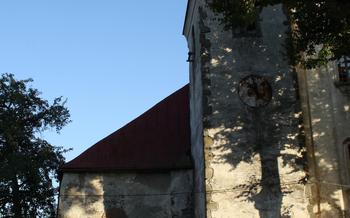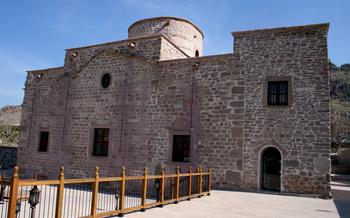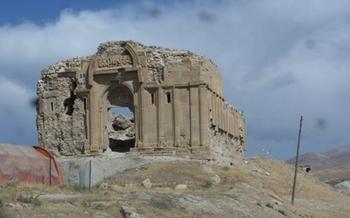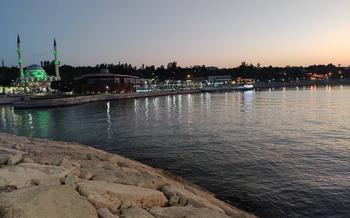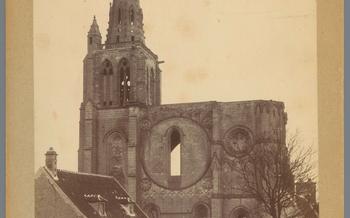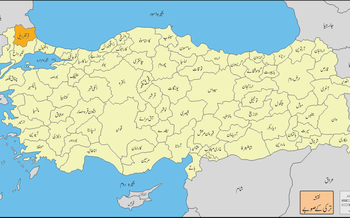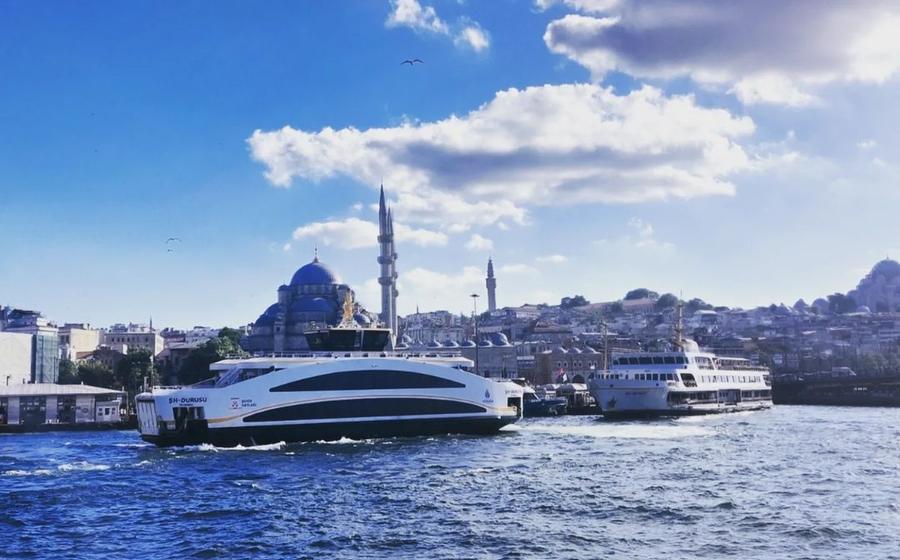
Ernis (Yedi Kilise) Church
- History of the Ernis (Yedi Kilise) Church
- Exploring the Ernis (Yedi Kilise) Church
- Attending Services at the Ernis (Yedi Kilise) Church
- Events and Festivals at the Ernis (Yedi Kilise) Church
- Photography at the Ernis (Yedi Kilise) Church
- Souvenirs and Shopping at the Ernis (Yedi Kilise) Church
- Food and Drink Near the Ernis (Yedi Kilise) Church
- Safety Tips for Visiting the Ernis (Yedi Kilise) Church
- Accessibility for Visitors with Disabilities
- Additional Tips for Planning Your Visit
- Insider Tip: Discover the Hidden Gem of Akdamar Island
History of the Ernis (Yedi Kilise) Church
The Ernis (Yedi Kilise) Church, also known as the Church of the Seven Churches, holds a significant place in the annals of Christianity. Its origins can be traced back to the 4th century AD, when Saint Thaddeus, one of the twelve apostles of Jesus Christ, is believed to have visited the region. Inspired by his teachings, the local population embraced Christianity, and the church was constructed as a testament to their newfound faith.
Over the centuries, the Ernis Church underwent several renovations and expansions. In the 6th century, Emperor Justinian I ordered the construction of a larger basilica, transforming the church into a prominent center of worship. Its strategic location along ancient trade routes further contributed to its importance, attracting pilgrims and missionaries from across the Byzantine Empire.
The church's architectural style reflects a blend of early Christian and Byzantine influences. Its impressive facade features intricate carvings and decorative elements, while the interior boasts a spacious nave and a series of side chapels. The church's well-preserved mosaics and frescoes depict biblical scenes and the lives of saints, offering a glimpse into the artistic and theological expressions of the early Christian era.
The Ernis Church's significance extends beyond its historical and architectural value. It is revered as one of the seven churches mentioned in the Book of Revelation, adding to its spiritual importance for Christians worldwide. Its inclusion as a UNESCO World Heritage Site in 2016 further underscores its exceptional cultural and religious significance.
Exploring the Ernis (Yedi Kilise) Church
The Ernis (Yedi Kilise) Church is a unique and fascinating place to visit. The church is laid out in a cross shape, with a central nave and two side aisles. The nave is lined with columns, which support the vaulted ceiling. The walls of the church are decorated with frescoes and mosaics, which depict scenes from the Bible.
The main features of the church include the altar, the pulpit, and the baptistery. The altar is located at the east end of the church, and it is made of marble. The pulpit is located on the south side of the church, and it is made of wood. The baptistery is located at the west end of the church, and it is made of stone.
Among the notable artifacts and relics in the church are the reliquary of Saint John the Baptist, the icon of the Virgin Mary, and the cross of Christ. The reliquary of Saint John the Baptist is a silver casket that contains the skull of the saint. The icon of the Virgin Mary is a painting that is said to have been made by Saint Luke. The cross of Christ is a wooden cross that is said to have been used by Jesus Christ during his crucifixion.
In addition to its main features, the Ernis (Yedi Kilise) Church is also home to a number of hidden details and symbolism. For example, the number seven is used throughout the church, representing the seven churches of the Apocalypse. The church is also decorated with a number of symbols, such as the dove, the fish, and the lamb, which represent the Holy Spirit, Jesus Christ, and the faithful.
Attending Services at the Ernis (Yedi Kilise) Church
The Ernis (Yedi Kilise) Church is an active place of worship, and attending a service is a rewarding experience for both pilgrims and visitors. Services are held regularly, and visitors are welcome to join the congregation. The schedule of services varies depending on the time of year, but there are typically services held on Sundays and major religious holidays. Services are conducted in Armenian, with some English translation available.
A dress code is required for attending services at the Ernis (Yedi Kilise) Church. Visitors should dress modestly, with shoulders and knees covered. Women may also be asked to cover their heads with a scarf. It is important to be respectful of the local customs and traditions when attending services.
Visitors should arrive at the church a few minutes before the service begins. This will give them time to find a seat and settle in. Services typically last for about an hour, and visitors are free to leave at any time.
Attending a service at the Ernis (Yedi Kilise) Church is a unique opportunity to experience the vibrant religious culture of Van. It is a meaningful and enriching experience that will leave visitors with a lasting impression.
Events and Festivals at the Ernis (Yedi Kilise) Church
The Ernis (Yedi Kilise) Church is a place of religious and cultural significance, and it hosts a variety of events and festivals throughout the year. These events bring together the local community and visitors from all over the world to celebrate the church's rich history and traditions.
One of the most popular festivals is the annual feast of Saint George, which takes place on May 6th. This festival attracts thousands of pilgrims and visitors who come to pay homage to the saint and to enjoy the festivities. The festival features traditional music, dancing, and food, as well as religious services.
Other important events and festivals at the Ernis (Yedi Kilise) Church include the Feast of the Assumption (August 15th), the Feast of the Nativity of the Virgin Mary (September 8th), and the Feast of the Epiphany (January 6th). These festivals are celebrated with special services, processions, and other events.
In addition to religious festivals, the church also hosts a variety of cultural events, such as concerts, art exhibitions, and lectures. These events provide an opportunity for visitors to learn more about the church's history and culture, and to experience the vibrant community that surrounds it.
Photography at the Ernis (Yedi Kilise) Church
The Ernis (Yedi Kilise) Church offers a wealth of opportunities for photography enthusiasts to capture the beauty and grandeur of this ancient site. The best time of day for photography is early in the morning or late in the afternoon, when the soft, golden light highlights the intricate details of the architecture and the surrounding landscape.
To capture the full essence of the church, use a wide-angle lens to take sweeping shots of the exterior, showcasing the impressive size and scale of the building. For more intimate details, zoom in on the intricate carvings, frescoes, and mosaics that adorn the interior walls and ceilings.
Experiment with different angles and perspectives to create unique and dynamic compositions. Try shooting from a low angle to emphasize the towering height of the church, or climb to a higher vantage point to capture the panoramic views of the surrounding countryside.
And don't forget to take advantage of the natural beauty of the site. The church is surrounded by lush gardens and groves of trees, which provide a picturesque backdrop for your photographs. With its rich history, stunning architecture, and natural beauty, the Ernis (Yedi Kilise) Church is a photographer's paradise, waiting to be explored and immortalized through the lens of your camera.
Souvenirs and Shopping at the Ernis (Yedi Kilise) Church
-
Where to buy souvenirs: There are several souvenir shops located in the vicinity of the Ernis Church, offering a variety of religious and cultural items. You can find these shops along the main road leading to the church and in the surrounding area.
-
What to buy: Some popular souvenirs include rosaries, crosses, olive wood carvings, ceramic pottery, and hand-woven textiles. You can also find unique items such as replicas of the church's architecture, jewelry with Christian symbolism, and traditional Turkish handicrafts.
-
Prices and bargaining: Prices for souvenirs vary depending on the item and the shop. It is customary to bargain in Turkey, so feel free to negotiate a fair price. Be prepared to pay in Turkish Lira (TL), as most shops do not accept foreign currencies.
-
Supporting local artisans: By purchasing souvenirs from local artisans, you can help support the preservation of traditional crafts and contribute to the local economy. Many of the souvenirs are handmade with love and care, making them truly special and meaningful.
Food and Drink Near the Ernis (Yedi Kilise) Church
After a spiritually enriching visit to the Ernis (Yedi Kilise) Church, tantalize your taste buds with the delectable culinary offerings in the vicinity. Immerse yourself in the vibrant flavors of Turkish cuisine, renowned for its fresh ingredients, aromatic spices, and generous portions.
Stroll along the charming streets surrounding the church and discover an array of restaurants, cafés, and coffee shops catering to every palate and budget. Indulge in traditional Turkish dishes such as succulent kebabs, savory gözleme (stuffed flatbread), or the hearty lentil soup, mercimek çorbası.
For a truly authentic experience, venture into the local market and sample the mouthwatering street food. Delight in freshly baked simit (sesame-encrusted bread rings), crispy fried kumpir (stuffed potatoes), or the irresistible döner kebab, a rotating skewer of thinly sliced meat served with pita bread and fresh vegetables.
Vegetarians and vegans will find a haven in Van, with an abundance of meat-free options available. Explore the colorful array of meze (small plates) such as hummus, baba ghanoush, and cacık (cucumber-yogurt dip). Savor the wholesome flavors of güveç (clay pot stew) or yaprak sarma (stuffed vine leaves) bursting with fresh herbs and vegetables.
Pair your culinary adventure with a refreshing glass of ayran (salty yogurt drink) or indulge in the rich aroma of Turkish coffee, a UNESCO-recognized cultural heritage. As you sip your kahve, soak in the vibrant atmosphere of Van, where the past and present intertwine in a harmonious blend of culture and tradition.
Safety Tips for Visiting the Ernis (Yedi Kilise) Church
When visiting the Ernis (Yedi Kilise) Church, it is important to take the necessary precautions to ensure a safe and enjoyable experience. Here are some safety tips to keep in mind:
- General Safety Precautions:
- Be aware of your surroundings and keep an eye on your belongings, especially in crowded areas.
- Avoid walking alone at night, particularly in isolated areas.
- Dress modestly and respect local customs to avoid attracting unwanted attention.
-
Be cautious of individuals offering unsolicited assistance or tours, as they may be attempting to scam you.
-
Beware of Pickpockets and Scams:
- Pickpockets are known to operate in tourist areas, so be vigilant and keep your valuables secure.
-
Be skeptical of individuals offering to exchange money or sell goods at inflated prices.
-
Respect Local Customs and Traditions:
- Remember that you are a guest in a foreign country, and it is important to respect local customs and traditions.
-
Be mindful of religious and cultural sensitivities, and avoid engaging in any disrespectful or offensive behavior.
-
Emergency Contact Information:
- Keep the contact information of your embassy or consulate handy in case of an emergency.
- Familiarize yourself with the local emergency numbers and how to contact the police or medical assistance if needed.
Accessibility for Visitors with Disabilities
The Ernis (Yedi Kilise) Church has been recognized for its commitment to accessibility, ensuring that visitors with disabilities can have a fulfilling and enriching experience. Wheelchair accessibility is a top priority, with designated ramps, elevators, and accessible restrooms throughout the complex. The church also provides sign language interpretation services upon request, enabling visitors with hearing impairments to fully participate in guided tours and religious services. For visually impaired individuals, audio guides are available, offering detailed descriptions of the church's architectural features, history, and artifacts. Additionally, designated parking spaces are reserved near the entrance for visitors with disabilities, ensuring convenient access to the church.
Additional Tips for Planning Your Visit
To make the most of your visit to the Ernis (Yedi Kilise) Church, consider the following tips:
-
Best time of year to visit: Spring (April-May) and autumn (September-October) offer pleasant weather for outdoor exploration.
-
Packing essentials: Bring comfortable walking shoes, a hat, sunscreen, and a camera. Layers are recommended for unpredictable weather.
-
Currency exchange and ATMs: Exchange currency before your trip or use ATMs in Van to avoid unfavorable rates.
-
Language barriers and communication: Learn basic Turkish phrases or download a translation app. Some locals may speak English, but it's not widely spoken.
Insider Tip: Discover the Hidden Gem of Akdamar Island
For an unforgettable off-the-beaten-path experience, take a short boat trip from Van to Akdamar Island, located in the shimmering waters of Lake Van. This tranquil island is home to the beautiful Akdamar Church, an Armenian masterpiece that dates back to the 10th century. With its intricate carvings, colorful frescoes, and stunning lake views, Akdamar Church is a true hidden gem that offers a glimpse into the rich history and culture of the region. Capture breathtaking photos of this architectural marvel, wander through the peaceful gardens, and soak in the serene atmosphere of this sacred site.

